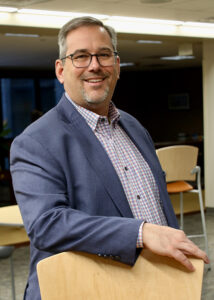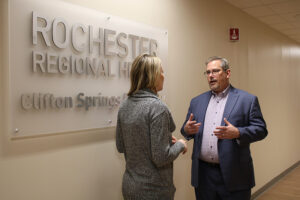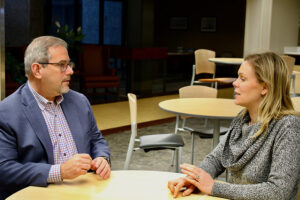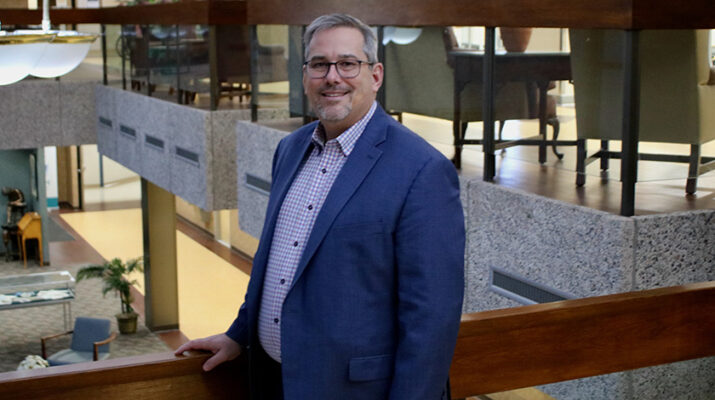Dan Ireland has tracked a path from bedside nursing to C-level hospital leadership
By John Addyman

For most of us, there’s one day that stands out crystalline and piercing: we remember exactly where we were and what we were doing when the first plane hit the World Trade Center.
In the healthcare community, a different and even more significant event occurred. It didn’t happen in one day. It was a realization, a shock hitting you in the face.
Dan Ireland provides an example.
“We were sitting in my office at the hospital, looking at the emergency room tracker board,” he said. “We had 18 beds in the ER and a couple of hall beds. In a half-hour’s time, the ER had 28 new patients. My director of nursing and I both got up from our chairs and said, ‘We need to go down there and help!’ And we did. I spent the next 12 hours practicing bedside nursing like I used to years ago — I’m not sure I could have gotten a med out of the med system — but I was transporting people and doing vital signs. I was doing what I could.”
COVID-19 had come to United Memorial Medical Center in Batavia.
Ireland, corporate suit and all — he is the president and chief operating officer of Rochester Regional’s three Finger Lakes Rural Hospitals at Newark-Wayne, Clifton Springs and UMMC — did what he could at that moment to meet an immediate need.
For him, it was an act that came naturally. “I believe that’s what leadership is,” he said. “Sometimes we have to step in and help whatever way we can.”
The COVID-19 days gave every healthcare worker pause. Ireland led his staff by examples, many of them small but none insignificant. He parked his car at the lot at St. Jerome’s Hospital and took a shuttle to UMMC, using the opportunity to talk to staff members on the way, sharing information and feelings about what everyone in the hospital was facing as the pandemic blew up.
He had an added purpose in parking offsite.
“It was a measure to make sure we had a parking spot for patients back at the UMMC campus,” he said. “It was my responsibility to do that and others followed.”
Gaining recognition for setting examples is something Ireland brought to healthcare when he started, right out of high school, in the St. Jerome hospital service. He had started school at Genesee Community College, wanting to be a computer programmer. Indeed, part of that desire is still in him.
“I was an intermediate EMT,” he explained. “There was a crossroads for me at that time — either go to paramedic school and commit to doing EMS or go into the nursing profession — that’s where I stayed and I stay inspired.
“There were nurses, female and male, at St. Jerome’s emergency department and eventually Genesee Memorial, who took me under their wings and showed me what nursing could be like and how they provided care.”
Steady Promotions

Dan Ireland became a registered nurse in 1992. He added his BS degree in nursing two years later. An MBA in IT and finance from RIT followed in three years. By 2005 Ireland was vice president of clinical service after serving as the ED nurse manager and clinical analyst and director of quality management in Batavia. He became VP of operations and chief operating officer at UMMC in 2010. Three years later he led the merger that has become the Finger Lakes Rural Hospitals.
Ireland made the improbable trip from bedside nursing to a C-level office.
Then the gift of COVID-19 fell on him.
Goethe said what doesn’t kill you makes you stronger and Ireland has been tempered by COVID-19. The way he and his staff responded to it has changed — and will continue to change — the look of healthcare in their rural community hospitals.
“We are in the most significant transformation of healthcare that I’ve witnessed in my 33 years,” he said with no hesitation. “We have no choice but to fundamentally think differently about how healthcare is provided, both in hospital care and outpatient care. I often tell my team, it is the most exciting time to be in healthcare, yet it can also be the most scary because there are still many unknowns that have yet to reveal themselves. Every change has a ripple to other changes. As we make a change in one area, we have to be mindful to what that does elsewhere. Opening up a clinic over here changes the way healthcare is provided in those communities.
“You want to make all these changes, but you have to maintain the quality of healthcare you provide today. You have to always have a keen focus on quality and engagement. The other challenge is we have a whole lot of non-healthcare people out here who have to ride this change with us. We have to be able to demonstrate that doing care differently — sometimes telehealth is the right visit and sometimes it’s not the right visit. We have to help people discern that.
“Then there’s the fact that the cost and healthcare finance over the years has been woefully neglected by the payor systems, the governmental payor systems as well. You’re getting Medicaid dollars that are 68 cents on the dollar — to cover the cost of healthcare. We see growing numbers of people on Medicaid. Something has to balance out there.”
Technology driving changes

He said the first things to change in healthcare will be spurred by technology.
“Finding different ways of interacting with patients. I think when we take artificial intelligence and layer it on top of that, we start allowing algorithms to help with decision making to pinpoint accuracy. I think those are the changes people haven’t embraced fully yet and maybe haven’t really contemplated. But those are things we’re anticipating looking at,” he said.
Ireland unwound a specific instance where artificial intelligence may come into play.
“We have shortages in many medical specialties out there — radiologists, pathologists — those type of roles. Some of that medical work can’t be fully replaced — but some of it can be augmented by AI. Reading radiology images as a first pass to lighten the load of the radiologist could help us. It’s being worked on and studied in England right now. Those are things I see we’re going to have to prepare for. We have to build structures to prepare for that.
“I think AI can help nurses at the bedside. There are so many functions that require multiple checks and involve multiple people and you don’t always have the people to do that. You want to shore that up and free up the time. Technology is going to free up time so our staff can focus on the right things and have more contact time with patients and less time doing administrative tasks.
“Having the nurse teaching a patient about that medication or teaching a patient about their therapy and using their nursing skillset — that’s top-of-license care, taking administrative tasks away from nurses. There was a time when you had nurses sitting at a desk answering phones. Unless they’re using that phone to make a clinical decision, you’re not leveraging their nursing skillset the way it was intended to be used. We want to take all those tasks off the table.
“Rochester General and Unity, for example, are using transfer robots now. Nurses used to run from the unit down to the pharmacy to get meds or down to the supply room to get stuff. You want those nurses at bedside performing the clinical functions they were trained to do. Let the robot deliver the goods. They’re called MOXI units. They’re cool little guys.”
Ireland is convinced that hospitals will change from within, driven by the experts who work there.
“At Rochester Regional we developed our first center of innovation lab out at Batavia, rooms designed to bring staff in and have them ideate, come up with ways to make their work more efficient and only they can come up with those ideas. How do we change a routine on their unit? That’s not something I can change in my office or the board room, it’s got to come from them.”
Mark Soell, the former CEO of UMMC before the merger and still a board member, was Ireland’s mentor.
“Dan is very even-keeled, very energetic and ambitious. He is also a person who really cares about patients and our staff. His empathy with people and ability to connect with staff at every level of the organization is really excellent,” he said.
Now the direction of three hospitals is in Ireland’s hands.
“One of the most exciting things I do now is to focus on rural healthcare and the special needs we have in our community hospitals. I’m not doing open-heart surgery or brain surgery in our hospitals, but how can I leverage the more routine things that patients can get locally in our communities? How can I advocate for the resources to do that?”
As an example, he said more orthopedic procedures should be done in local, rural hospitals.
“It won’t be acceptable to say those procedures should go to a bigger hospital. You need the bigger hospitals to do the complex procedures,” he said. “How do we prepare ourselves for the coming needs in rural healthcare and how do we manage resources that are finite?”
Getting professionals out to the burbs is another challenge.
Ireland is having none of that. For him — and he’s living proof — the reality is that there is opportunity and excellence in rural medicine.
“We have fantastic healthcare people here,” he said. “I work with some of the best clinicians, the most compassionate people that I have ever met who go to great lengths to make sure our patients are taken care of. I couldn’t be more honored. It’s what gets me up in the morning. I get to come in here and interact with people whom I know care…a lot of people go to jobs and don’t get to say that.”

